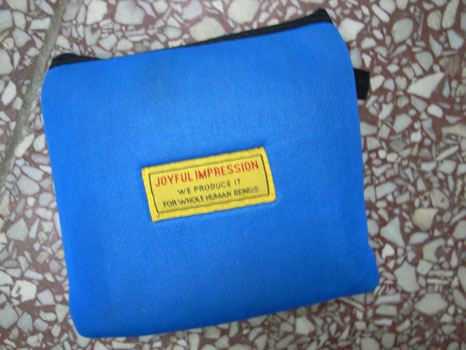The crux of this situation is one of returning to an academic reportage—after the holiday, after the event, after stepping out of the heretofore all-encompassing realm that is the Home and learning to tell or recount (and what not) to our classmates, our teachers, our friends. Spending the entire summer hanging out by the pool and eating sandwiches with the crusts cut off may have been real life. But how much of a real life do we access, relive, or reveal when writing about our experiences, passing them on to others, or trying to capture them via other media simultaneous to the experience (i.e., photographs, audio recording, drawing, etc.)? If we make art from/of our lives are the results still a reflection of the world we live in, and how much do we really reveal about ourselves through the process? More? Less? Is life as recorded in a journal, a newspaper, an uploaded video or a painting symmetrical to “mere life”? Or parallel?
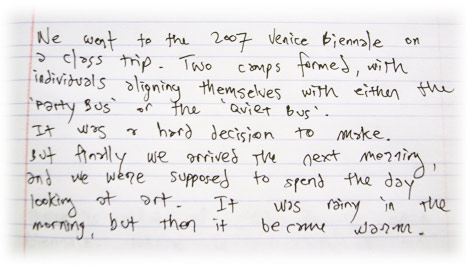 The question of life in art is not at least in part a question of reality and document, of truth and artifact. Insofar that life is being, it is the living element of a work of art, its energeia, which we recognise, or recognises us, is capable of moving us beyond our own mere lives towards truth and Heidegger’s sense of the world worlded, “more fully in being than the tangible and perceptible realm in which we believe ourselves to be at home.” To find, then, the evocation of life in the artwork does not set up a dichotomy as implied by the analogy of reality to document, truth to artifact. We can look perhaps more towards Adorno’s dialectics, not by way of simple polarities but a dialecticalism whereby one is contained in the other—art and life mutually inherent.
The question of life in art is not at least in part a question of reality and document, of truth and artifact. Insofar that life is being, it is the living element of a work of art, its energeia, which we recognise, or recognises us, is capable of moving us beyond our own mere lives towards truth and Heidegger’s sense of the world worlded, “more fully in being than the tangible and perceptible realm in which we believe ourselves to be at home.” To find, then, the evocation of life in the artwork does not set up a dichotomy as implied by the analogy of reality to document, truth to artifact. We can look perhaps more towards Adorno’s dialectics, not by way of simple polarities but a dialecticalism whereby one is contained in the other—art and life mutually inherent.![]() Even so, the “mere life” evoked in a work of art is by no means equal to reality. The distance between the two can be described as a greater truth or a place of the spirit, but perhaps, much less glamourously—not so far off from the gap between seeing someone’s endless vacation slideshow versus having been part of the real experience. One approaches a higher plane of being, the other is, very often, just a bore.
Even so, the “mere life” evoked in a work of art is by no means equal to reality. The distance between the two can be described as a greater truth or a place of the spirit, but perhaps, much less glamourously—not so far off from the gap between seeing someone’s endless vacation slideshow versus having been part of the real experience. One approaches a higher plane of being, the other is, very often, just a bore.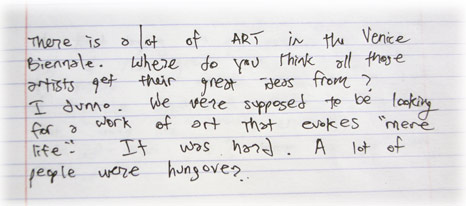 At the Biennale di Venezia, a near Disneyland of contemporary art and national identity, we are afforded the small world after all of contemporary art multiculturalism. The short examples following interest me here as different national perceptions positioning life relative to art. The stereotypes that emerge are perhaps an ironically self-conscious colouring of the ways the simulacra overtakes us even in self-presentation, but at the current stage of hyper visual culture, it is possible in this context to raise new questions regarding art as presentation (show, artifact, material, object) versus documentation (alternate reality, report, medium, subject).
At the Biennale di Venezia, a near Disneyland of contemporary art and national identity, we are afforded the small world after all of contemporary art multiculturalism. The short examples following interest me here as different national perceptions positioning life relative to art. The stereotypes that emerge are perhaps an ironically self-conscious colouring of the ways the simulacra overtakes us even in self-presentation, but at the current stage of hyper visual culture, it is possible in this context to raise new questions regarding art as presentation (show, artifact, material, object) versus documentation (alternate reality, report, medium, subject).![]() Japan, History and Tradition.The most physically direct form of document was created by artist Masao Okabe for the Japan pavilion. His work consisted of a series of 1,400 frottages made with pencil on paper, rubbed directly on the surface of stones that made up the World War II bombed platforms of the former Ujina train station in Hiroshima. Okabe’s work is a document of history, a literal tracing of stone as the ultimate testament to the fragilities wrought by war, where even rock is impermanent, its solidity transferred into the grainy shades produces by a sketch, no more certain than the dead flowers and leaves pressed under glass throughout the installation. His is a document of “mere life” in its most physical approach, but its results question the viability of history via transference across artifact, time and medium.
Japan, History and Tradition.The most physically direct form of document was created by artist Masao Okabe for the Japan pavilion. His work consisted of a series of 1,400 frottages made with pencil on paper, rubbed directly on the surface of stones that made up the World War II bombed platforms of the former Ujina train station in Hiroshima. Okabe’s work is a document of history, a literal tracing of stone as the ultimate testament to the fragilities wrought by war, where even rock is impermanent, its solidity transferred into the grainy shades produces by a sketch, no more certain than the dead flowers and leaves pressed under glass throughout the installation. His is a document of “mere life” in its most physical approach, but its results question the viability of history via transference across artifact, time and medium.![]() France, Love.Sophie Calle’s work can also be said to be evocative of “mere life” in the sense that it is largely autobiographical, and the source of her piece for the French pavilion is no exception, although this time Calle succeeds in moving her story outside of her own life and recapturing it through others— 107 other women, precisely. By asking each of the participants to translate, interpret or explain a break-up letter received from her lover, Calle is able to create a prism of images of the lives and perspectives of these women, revoiced in the form of dance numbers, linguistic corrections and psychological diagnoses among others. Insodoing, the acuteness of a supposedly ‘real’ emotional situation becomes estranged, dramatised and made multiplicitous. “Mere life” is simply a matter of perspective.
France, Love.Sophie Calle’s work can also be said to be evocative of “mere life” in the sense that it is largely autobiographical, and the source of her piece for the French pavilion is no exception, although this time Calle succeeds in moving her story outside of her own life and recapturing it through others— 107 other women, precisely. By asking each of the participants to translate, interpret or explain a break-up letter received from her lover, Calle is able to create a prism of images of the lives and perspectives of these women, revoiced in the form of dance numbers, linguistic corrections and psychological diagnoses among others. Insodoing, the acuteness of a supposedly ‘real’ emotional situation becomes estranged, dramatised and made multiplicitous. “Mere life” is simply a matter of perspective.![]() China, Future. Cao Fei’s use of the internet portal Second Life to create her video installation for the Chinese pavilion brings ‘reality’ directly into the art world, as it investigates a phenomenon that is transpiring in the immediate present, being translated across media from a virtuality through the internet to a mass phenomenon, not necessarily in terms of users but certainly by press coverage. The irony and fascination that Second Life poses for both Cao and the media is that the form of reality proposed by it is one that projects itself as a future for everyone, and the ambivalent possibilities proffered by this future are ones that reacts back upon the present of our “mere” everyday realities. Her documentary made entirely from footage of the voyages of her Second Life avatar, China Tracy, turn the strangely connected but utterly desolate world before us into a montage of cinematic moments, like nostalgic flashbacks of something not yet experienced.
China, Future. Cao Fei’s use of the internet portal Second Life to create her video installation for the Chinese pavilion brings ‘reality’ directly into the art world, as it investigates a phenomenon that is transpiring in the immediate present, being translated across media from a virtuality through the internet to a mass phenomenon, not necessarily in terms of users but certainly by press coverage. The irony and fascination that Second Life poses for both Cao and the media is that the form of reality proposed by it is one that projects itself as a future for everyone, and the ambivalent possibilities proffered by this future are ones that reacts back upon the present of our “mere” everyday realities. Her documentary made entirely from footage of the voyages of her Second Life avatar, China Tracy, turn the strangely connected but utterly desolate world before us into a montage of cinematic moments, like nostalgic flashbacks of something not yet experienced.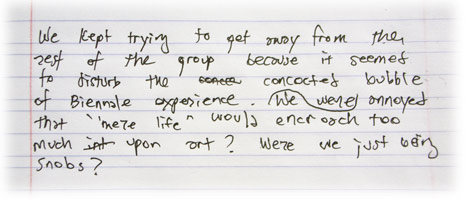 Why am I writing this again?
Why am I writing this again?![]() Oh yes, Biennale experience. Mere life.
Oh yes, Biennale experience. Mere life.![]() Is it a coincidence that this question of mere life is actually one of the primary themes of this year’s Documenta exhibition? Perhaps we should look outside of the context of a self-inflated art exhibition towards another, slightly-less-self-inflated-but-on-the-Grand-Tour-nonetheless art exhibition to get back to this question of mere life.
Is it a coincidence that this question of mere life is actually one of the primary themes of this year’s Documenta exhibition? Perhaps we should look outside of the context of a self-inflated art exhibition towards another, slightly-less-self-inflated-but-on-the-Grand-Tour-nonetheless art exhibition to get back to this question of mere life.![]() Or, perhaps mere life is merely in the looking.
Or, perhaps mere life is merely in the looking.![]() I’ll let you know after we get to Kassel.
I’ll let you know after we get to Kassel.
somewhere not around you
 “The schizo knows how to leave: he as made departure into something as simple as being born or dying. But at the same time his journey is strangely stationary, in place. he does not speak of another world, he is not from another world: even when he is displacing himself in space, his is a journey in intensity, around the desiring-machine that is erected here and remains here. For here is the desert propagated by our world, and also the new earth, and the machine that hums, around which the schizos revolve, planets for a new sun. These men of desire—or do they not yet exist?—are like Zarathustra. They know incredible sufferings, vertigos, and sicknesses. They have their specters. They must reinvent each gesture. But such a man produces himself as a free man, irresponsible, solitary, and joyous, finally able to say and do something simple in his own name, without asking permission; a desire lacking nothing, a flux that overcomes barriers and codes, a name that no longer designates any ego whatever. He has simply ceased being afraid of becoming mad. He experiences and lives himself as the sublime sickness that will no longer affect him.” [Deleuze & Guattari, Anti-Oedipus]
“The schizo knows how to leave: he as made departure into something as simple as being born or dying. But at the same time his journey is strangely stationary, in place. he does not speak of another world, he is not from another world: even when he is displacing himself in space, his is a journey in intensity, around the desiring-machine that is erected here and remains here. For here is the desert propagated by our world, and also the new earth, and the machine that hums, around which the schizos revolve, planets for a new sun. These men of desire—or do they not yet exist?—are like Zarathustra. They know incredible sufferings, vertigos, and sicknesses. They have their specters. They must reinvent each gesture. But such a man produces himself as a free man, irresponsible, solitary, and joyous, finally able to say and do something simple in his own name, without asking permission; a desire lacking nothing, a flux that overcomes barriers and codes, a name that no longer designates any ego whatever. He has simply ceased being afraid of becoming mad. He experiences and lives himself as the sublime sickness that will no longer affect him.” [Deleuze & Guattari, Anti-Oedipus]
.but must i choose between truth and light, untruth and darkness? you and your sickness affect me, and so what then of it, you prick. must i take part, too, so long as you are happy? your cultural bullshit makes a we of i, but then what of the you? before it was about getting rid of this dance, the pronouns, because yes, we are all human, but your little hurricane can play with notions of society and take off when and if you please. what is wrong with choosing society, with wanting it, to take part in it, isn’t that here, too? i live it, plug into it every fucking day, on the bus, i wake up, step up, into, and fall back asleep again. some days are better than others. spring comes again. a mud ball shines like porcelain. i would like we to be happy, too. but if it’s my neurosis, your psychosis, still wanting to accept, just “somewhere not around you.” my love is a fucking wall right now, coupled with half-truths, awe-struck darkness and the grossest sadness. thanks for the process.
Posted by 丫 | more »toward a theory of the designwork Posted by 丫 | more »
not-yet-expired activity
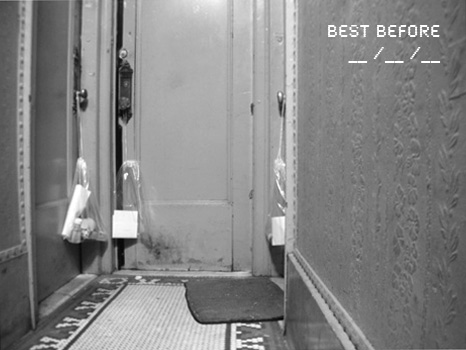 [readings for Best Before; this is what we’re up to; arnhem, boston and beijing in new york, August-October 2006]
[readings for Best Before; this is what we’re up to; arnhem, boston and beijing in new york, August-October 2006]
“The separation between a thing and its environment cannot be absolutely definite and clear-cut; there is a passage by insensible gradations from the one to the other; the close solidarity which binds all the objects of the material universe, the perpetuality of their reciprocal actions and reactions, is sufficient to prove that they have not the precise limits which we attribute to them. Our perception outlines, so to speak, the form of their nucleus; it terminates them at the point where our possible action upon them ceases, where, consequently, they cease to interest our needs. Such is the primary and the most apparent operation of the perceiving mind: it marks out divisions in the continuity of the extended, simply following the suggestions of our requirements and the needs of practical life.” —from Matter and Memory, Bergson
“We ought to think of the historical world according to this model. Why ask if history is made by men or by things, since it is obvious that human initiatives do not annul the weight of things, and the ‘force of things’ always acts through men? It is just this failure of analysis, when it tries to bring everything down to one level, which reveals history’s true milieu. There is no ‘last analysis,’ because there is a flesh of history in which (as in our own body) everything counts and has a bearing — the infrastructure, our idea of it, and above all the perpetual exchanges between the two in which the weight of things becomes a sign as well, thoughts become forces, and the balance of the two becomes events. It is asked, ‘Where is history made? Who makes it? What is this movement which traces out and leaves behind the figures of the wake?’ It is of the same order as the movement of Thought and Speech, and, in short, of the perceptible world’s explosion within us. Everywhere there are meanings, dimensions, and forms in excess of what each ’consciousness‘ could have produced, and yet it is men who speak and think and see. We are in the field of history as we are in the field of language or existence.”These transformations of private into public, of events into meditations, of thought into spoken words and spoken words into thought, this echo coming from everywhere makes it such that in speaking to others we also speak to ourselves, and speak of what exists. This swarming of words behind words, thoughts behind thoughts–this universal substitution is also a kind of stability.” —from Signs, Merleau-Ponty
“Take, for example, a small drawer, which the carpenter has made for the convenience of some housefold. With the passage of time, the actual form of this drawer is surpassed by time itself and, after the decades and centuries have elapsed, it is as though time had become solidified and had assumed that form. A given small space, which was at first occupied by the object, is now occupied by solidified time. It has, in fact, become the incarnation of a certain form of spirit. —from Kinkakuji, Mishima
Posted by secretary | reply »“oh…nothing” or “can i borrow your jams?”
to this day, nothing. like a to-do list, for you, upon arrival: “turn on the a/c, watch cable, cook, sleep, take long showers, walk around the neighbourhood, look out of the window, do yoga on the floor, read. see you next week, enjoy the house. love, lucio”.apologies for laughing too much, laughing being a sign of rudeness in many societies or situations, as in when the extremely overweight man sitting diagonally behind her shows extraordinary deftness in suddenly leaning back to ask “can i borrow your jams?” in slightly nasally voice and she responds equally deftly with a smooth pass of basket of assorted flavours of single portion jams. from in front of her, slightly on her right side, wicker basket of assorted flavours of single portion jams, to behind her, on her left, the man places the full wicker basket of assorted flavours of single portion jams next to his own wicker basket, which has only two jams left. at least as realistic as one can manage in memory, quite sur real, it becomes a consistent source of unnecessary laughter amongst the jam passer and her friend, who have deftly managed to translate it into chinese: 我可以借你的jams吗? oh nothing.. from the press release for nothing, now at the schirn kunsthalle frankfurt: “Friedman shows 1,000 Hours of Staring (1992-1997), a sheet of paper stared at by the artist for one thousand hours, which marks an art process beyond the concept of the instantia tion of the stroke of genius or divine inspiration. The work reflects the labors of a persistence leading to nothing. When Friedman is asked if he really took the trouble of staring at the paper for one thousand hours and when he starts speaking about how he made a meditation of it and kept note of his working hours, this is almost too explicit and specific, curtailing the imagination. In the end, the white paper induces a reflection on time, which, however, is almost entirely left to the viewer by the artists. Nothing is only where you don’t see anything.”.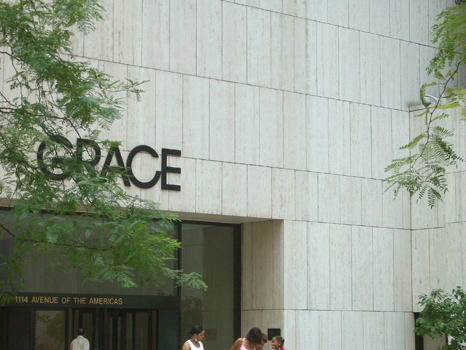 How, may i ask, may one stop seeing? The falafal stand man at 44th and 6th speaks better English than I do. And so does his mother, as she pulls out the fat wad of bills to give me change. chicken on rice. medium? Four dollars.Business is good today. Just behind, the Cotton Club has come to Grace, under a tent, they play jumping jack jive. There’s – mmbgh- -, there’s -st- -ard. I love it when they announce their names after solos, but today their microphones aren’t amped up enough, only chunky mumbling under the music. More black people take chairs up front. more white construction workers with sunglasses and bandannas sit on the ledge at the back. And when did the gypsies come to New York? Three of them each take a section of the square, each holding a sign in their hands telling how many children they have and dire looks on their faces. She has a black handbag creased flat under her arm, as if it came from the box. That old box. She talks to the man with big dreads concealed under bulbous knit cap, an unmoving black fishbowl attached to his shaking head. A stern almost-frown for the dejected, almost-sexy gypsy woman.Grace security arrives. Three gypsy women walk away with slow, almost-sexy lumbering steps under long skirts. Another man says something to the security guard, who watches the women steadfastly to make sure they leave Grace. You feel he is yelling in her ear, he is bent towards her in a yelling sort of way, though you hear but the softest murmur above the big band. You are only a few feet away.To see someone yelling but hear nothing.Behind the giant potted amaryllises, Asian woman takes a photo of Cotton Club. She blocks the path for red-haired fashion associate, who carries in her hands large presentation boards for the upcoming season. Red-haired fashion associate stops abruptly and rolls her eyes until Asian woman notices her and moves aside. The presentation boards move clumsily but quickly into 1114 avenue of the americas, otherwise known as the Grace building. Baudrillard never had it this good. It’s lunch hour.
How, may i ask, may one stop seeing? The falafal stand man at 44th and 6th speaks better English than I do. And so does his mother, as she pulls out the fat wad of bills to give me change. chicken on rice. medium? Four dollars.Business is good today. Just behind, the Cotton Club has come to Grace, under a tent, they play jumping jack jive. There’s – mmbgh- -, there’s -st- -ard. I love it when they announce their names after solos, but today their microphones aren’t amped up enough, only chunky mumbling under the music. More black people take chairs up front. more white construction workers with sunglasses and bandannas sit on the ledge at the back. And when did the gypsies come to New York? Three of them each take a section of the square, each holding a sign in their hands telling how many children they have and dire looks on their faces. She has a black handbag creased flat under her arm, as if it came from the box. That old box. She talks to the man with big dreads concealed under bulbous knit cap, an unmoving black fishbowl attached to his shaking head. A stern almost-frown for the dejected, almost-sexy gypsy woman.Grace security arrives. Three gypsy women walk away with slow, almost-sexy lumbering steps under long skirts. Another man says something to the security guard, who watches the women steadfastly to make sure they leave Grace. You feel he is yelling in her ear, he is bent towards her in a yelling sort of way, though you hear but the softest murmur above the big band. You are only a few feet away.To see someone yelling but hear nothing.Behind the giant potted amaryllises, Asian woman takes a photo of Cotton Club. She blocks the path for red-haired fashion associate, who carries in her hands large presentation boards for the upcoming season. Red-haired fashion associate stops abruptly and rolls her eyes until Asian woman notices her and moves aside. The presentation boards move clumsily but quickly into 1114 avenue of the americas, otherwise known as the Grace building. Baudrillard never had it this good. It’s lunch hour.
three routes leading to three different sites of Tender, each on a river
To the West, the route to “Tender on Gratitude” (Reconnaissance) passes through Kindness, Little Attentions, Assiduity, Willingness, Great Services, Sensibility, Tenderness, Obedience, Constant Friendship; losing one’s way might mean falling into Negligence, Inequality, Coolness, Lightness, and Forgetfulness, only to find oneself confronted by placid Lake Indifference. To the East, the way to “Tender on Esteem” means surviving Great Effort, Galant Letter, Love Letter, Sincerity, Big Heartedness, Probity, Generosity, Exactitude, Respect, and Benevolence; failure leads through Pride, Indiscretion, Perfidiousness, Slandermongering, and Maliciousness before arriving at the stormy Sea of Emnity. Finally, the direct route to “Tender on Inclination” passes through the town to the Dangerous Sea; beyond lies the unmappable Unknown Lands.
 [Anthony Vidler in “Terres Inconnues: Cartographies of a Landspace to be Invented,” reading Francois Chauveau’s Carte du pays de Tendre (1654)]
[Anthony Vidler in “Terres Inconnues: Cartographies of a Landspace to be Invented,” reading Francois Chauveau’s Carte du pays de Tendre (1654)]
17 february, after a cold bicycle ride, i taught her “msg”, oed teaches me
sturgeon’s Law Brit. /![]() st
st![]()
![]() d
d![]() (
(![]() )nz
)nz ![]() l
l![]()
![]() /, U.S. /
/, U.S. /![]()
![]() st
st![]() rd
rd![]()
![]() nz
nz ![]() l
l![]() / Forms: 19- Sturgeon’s Law, Sturgeon’s law. [Sturgeon (1918-85, born Edward Hamilton Waldo), U.S. science fiction writer + LAW n.1] A humorous aphorism which maintains that most of any body of published material, knowledge, etc., or (more generally) of everything is worthless: based on a statement by Sturgeon (see quot. 1958), usually later cited as ‘90 per cent of everything is crap’. Typically used of a specific medium, genre, etc., originally and esp. science fiction, and now freq. also of information to be found on the Internet. The aphorism was apparently first formulated in 1951 or 1952 at a lecture at New York University (letter to the O.E.D. from Fruma Klass, the wife of science fiction writer Phil Klass (‘William Tenn’), 5 Dec. 2001), and popularized at the 1953 WorldCon science fiction convention (see J. Gunn in N.Y. Rev. Sci. Fiction (1995) Sept. 20).
/ Forms: 19- Sturgeon’s Law, Sturgeon’s law. [Sturgeon (1918-85, born Edward Hamilton Waldo), U.S. science fiction writer + LAW n.1] A humorous aphorism which maintains that most of any body of published material, knowledge, etc., or (more generally) of everything is worthless: based on a statement by Sturgeon (see quot. 1958), usually later cited as ‘90 per cent of everything is crap’. Typically used of a specific medium, genre, etc., originally and esp. science fiction, and now freq. also of information to be found on the Internet. The aphorism was apparently first formulated in 1951 or 1952 at a lecture at New York University (letter to the O.E.D. from Fruma Klass, the wife of science fiction writer Phil Klass (‘William Tenn’), 5 Dec. 2001), and popularized at the 1953 WorldCon science fiction convention (see J. Gunn in N.Y. Rev. Sci. Fiction (1995) Sept. 20).
[1958 T. H. STURGEON in Venture Sci. Fiction Mar. 66/2 It is in this vein that I repeat Sturgeon’s Revelation, which was wrung out of me after twenty years of wearying defense of science fiction against the attacks of people..whose conclusion was that ninety percent of s f is crud. The Revelation: Ninety percent of everything is crud. 1963 J. MERRIL in Proc. Chicon III 35, I think it was probably the final statement which sort of eliminates this discussion but we will go ahead with it anyhow and that was the memorable Sturgeon Law that 90 per cent of everything is crud; including, we regret to say, science fiction.] 1963 T. R. COGSWELL in Proc. Chicon III 38 Judy [Merril] mentioned Sturgeon’s Law; she was kind enough not to bring the new revisions which is that 9/10ths of all science fiction is bad enough to be written by Ted Cogswell. 1968 in T. Sturgeon Way Home (new printing) (preceding title-page), One exception to Sturgeon’s Law. Ted Sturgeon was once approached by a Sorehead who said, ‘Ninety percent of science fiction is crud.’ Sturgeon fixed him (good) with a steely glance, and replied: ‘Yes, ninety percent of everything is crud.’ 1977 Washington Post (Nexis) 29 Aug. B1 What we’re in for in movies and television is a deluge… If I may I’d like to quote (sci-fi writer Theodore) Sturgeon’s Law: ‘90 per cent of everything is crap’. Television seems to bear that out. 1984 Computer Magazines in net.flame (Usenet newsgroup) 3 Feb., Is anyone else disgusted with what is happening to the computer magazines? I realize that Sturgeon’s law is a strong force..but this is getting putrid! 1996 PC World (Nexis) Dec., ‘Ever heard of Sturgeon’s law?’ He shook his head. ‘“Ninety percent of everything is crap.” If that’s true of anything, it’s true of the Web. Ninety percent of everything on it isn’t even worth the time it takes to download’. …yes, just stuff.
Posted by 丫 | more »from [10] You may also have known how the world might be changed
Edouard Glissant once discussed that “the idea of a non-linear time, coexistence of several time zones, would of course allow for a great variety of different contact zones”. Hans Ulrich Obrist quoted him in his introductory notes for the recent Guangzhou Triennial, talking about the multiplicity of the international art scene, in its boom of biennials, triennials, symposia and festivals, as a means for finding new ways to maneuver within the contemporary art dialectic. Mieszko calls it mingling.
I still get upset when I think about the time David passed it back to me, “Oh yeah, Tetsuo told me about it. He said it’s some kind of networking thing or something.” Among words in list of words to be negatively connoted–networking. In the present participle form, it’s 恶心, yuck, like a slimy handshake, knowing all the lines perfectly for your 吹自己牛 nice-to-meet-you-what-do-YOU-do-as-in-what-can-you-do-for-me kind of smirk. But hey, that’s a pretentious attitude refusing to deal with reality, now isn’t it? Could the thousands on myspace, friendster, and my giant stack of 名片 be wrong? Man needs man, even if it’s alien (I finally watched Solaris last night, it’s amazing). Networking implies something discursive, it moves to the level of culture, and, even if it’s superficial, it derives meaning from a discursive history. Would Wittgenstein say “We’ll keep in touch”?In noun form, the network is a giant and heady flag of our, add the sound of horns here, ahem, postmodern age. It is the price of oil and the blood attached to it; it is The Matrix; it is Kevin Bacon; it is MSN Messenger as office internal communication; it is French kids in Clichy-sous-Bois filming themselves with their mobile phones while they burn the streets then sell the footage to television stations. It is all of this, tangled into one incestuous whole. And somehow, it gains a certain objectivity in its vastness, the overwhelming inability to comprehend the, well—too simply stated—largeness. As in Alistair suddenly lying on his back in the middle of the interview, hands folded behind his head, this kind of feeling. But then it’s not objective at all anymore, becoming instead an indulgence in nostalgia for the present, as we are so often apt to do these days, making paintings that look like graphic design and engaging in voyeurism as the highest form of fantasy. Amidst the loss of ability to say anything new, anything of value, let’s document everything. Let’s make an archive because we don’t know exactly what we want, and actually, don’t we want everything?There is no point. And that is not among the list to be negatively connoted. Quite the opposite, I am discovering more and more, no point means finding a shape in the absence of a singular goal. Beijing the 坦大饼 pancake, the cookie or the doughnut—it is an experiment in urban yeast. Anouchka says circles, I say spirals. As in learning new words every day. As in trying to describe it to you better.
Posted by 丫 | reply »